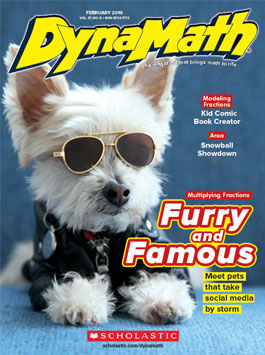We know your school days are busy and you time is limited. Which is why are happy to let you know how easy it is to share DynaMath issues and articles with your students using Google Classroom. You can do it in 3 easy steps.

How to Use DynaMath With Google Classroom
Share content in 3 easy steps
Sharing and assigning DynaMath content with Google Classroom is fast and easy
Assigning a DynaMath article on Google Classroom
1. Find the content you want and click the share icon
First, find the article you’d like to share. (Have you read our Giants of Generosity article? It’s a great character ed piece!) Then, click the share icon. A small menu (see image, right) will pop up with the choice to copy the link or share to Google Classroom. Select the Google Classroom option.
Choosing a class and action with Google Classroom
2. Enter Google Classroom
If you’re not already logged into Google Classroom, you’ll be prompted to sign in or make an account.
Once that’s done, you can create an assignment, ask a question, or make an announcement. These assignments, questions, and posts will appear on your stream, with a record of student engagement.
You can choose which students receive an assignment in Google Classroom.
3. Share content with students and track progress
In Google Classroom, you can share DynaMath content with your students in three ways: by creating an assignment, asking a question, or making an announcement. Here’s what you need to know.
When you create an assignment, you’ll see a screen that looks like the image above. You can customize your assignment in the following ways:
- Students: Use the dropdown menu to manually select which students receive the assignment. (All students in your Google Classroom are selected by default.) This is a fantastic tool for leveling!
- Title and instructions: Name your assignment and add any extra directions for your students.
- Due date: Pick a due date for timed assignments or leave the default “no due date” for open-ended projects.
- Topic: Tag assignments by topic to keep track of how they fit in to your curriculum. You can pick a tag you’ve used before from the dropdown menu or create a new one.
Once you’re finished on this screen, click "assign" and you’re ready to go!
Creating a multiple choice question in Google Classroom
Asking a question is very similar to creating an assignment, as you can see in the image above. What’s different is that you can ask two different types of questions:
- Short answer response: In this option, you can decide if you want to allow students edit their answer, and whether to let students reply to each other.
- Multiple-choice question: In this option, you can enter as many answer choices as you like, and decide if you want to to let students see responses from others in their class.
When you’re finished on this screen, click ask. The question will appear on your classroom’s stream.
Making an announcement in Google Classroom
Making an announcement is super simple—it’s just like sharing a post on Facebook or Twitter. You just need to pick the students and topic, and then you’re all set to post.
This is a great way to let students know when a new DynaMath issue or article is available.
Assignments, questions, and announcements appear in your Google Classroom stream.
Do you use Google Classroom? What other digital tools do you use to organize your classroom? We'd love feedback, so email us anytime.
Want more elementary math education tips and news? Check out Scholastic's archive.
Catherine Wilshusen is the online editor of DynaMath, SuperScience, Scholastic MATH, and Science World—Scholastic’s STEM magazines.
Recent Posts
-
July 7, 2021
SEL in the Math Classroom: Strategies for Resilience
-
January 30, 2019
Make the Most of DynaMath–With Google Classroom!
-
January 8, 2019
Easy Classroom Updates for 2020
-
December 3, 2019
4 Fun Ways to Use Math Around the Holidays
-
September 10, 2019
Fun Math Icebreaker Activity
Exciting ideas and fun teaching strategies for using DynaMath in 3rd, 4th, and 5th grade math classrooms


